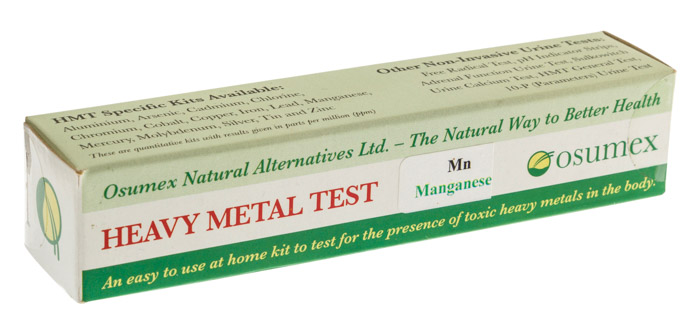Manganese Kit
how to test |
|
|
| Water Test Kit (2-test pack) |
| Adrenal Function Urine Test |
| Sulkowitch Urine (Calcium) Test |
|
|
|
MANGANESE
Number 25 on the "periodic table" of elements
Tests the presence of ions of manganese to a high degree of accuracy to
detect contamination in the body and on a wide range of materials in your environment
Manganese is a naturally occurring metal that is found in many types of rocks. Pure manganese is silver-colored,
but does not occur naturally. It combines with other substances such as oxygen, sulfur, or chlorine. Manganese
can also be combined with carbon to make organic manganese compounds. Common organic manganese compounds include
pesticides, such as maneb or mancozeb, and methylcyclopentadienyl manganese tricarbonyl (MMT), a fuel additive in
some gasolines.
Manganese is an essential trace element and is necessary for good health. Manganese can be found in several food
items, including grains and cereals, and is found in high amounts in other foods, such as tea.
Daily intake of small amounts of manganese is needed for growth and good health in children. Manganese is constantly
present in the mother and is available to the developing fetus during pregnancy. Manganese is also transferred from a
nursing mother to her infant in breast milk at levels that are appropriate for proper development.
Sources:
- Manganese can enter the air from iron, steel, and power plants, coke ovens, and from dust from mining operations.
- Manganese can enter the water and soil from natural deposits, disposal of wastes, or deposits from airborne sources.
- Manganese exists naturally in rivers, lakes, and underground water.
- Plants in the water can take up some of the manganese from water and concentrate it.
Exposure to Managese can occur in the following manner:
- Everyone is exposed to small amounts of manganese in air, water, and food.
- Individuals who work in occupations that mine or use manganese are likely to be exposed to excess levels in their work environment.
- People who improperly use pesticides such as maneb and mancozeb, may be exposed to excess levels.
Toxicity
A new study suggests that too much manganese, an essential element required by the body in tiny amounts but toxic at elevated levels, may
contribute to the early development of Parkinson's disease symptoms in susceptible people. Recent epidemiological studies have suggested an
association between Parkinson's disease and elevated exposure to manganese. The new study in animals shows that exposure to low levels of
manganese does not directly contribute to the disease, but affects a different part of the brain in a way that exacerbates the effects of
Parkinson's.
Chronic overexposure to manganese can lead to a disease known as manganism with symptoms similar to Parkinson's disease. But lower doses of
manganese that can cause more subtle health effects are not well known
Toxicity Symptoms
Some individuals exposed to very high levels of manganese for long periods of time in their work developed mental and emotional disturbances
and slow and clumsy body movements. This combination of symptoms is a disease called "manganism." Workers usually do not develop symptoms of
manganism unless they have been exposed to manganese for many months or years. Manganism occurs because too much manganese injures a part of
the brain that helps control body movements.
Exposure to high levels of airborne manganese, such as in a manganese foundry or battery plant, can affect motor skills such as holding one's
hand steady, performing fast hand movements, and maintaining balance. Exposure to high levels of the metal may also cause respiratory
problems and sexual dysfunction.
The EPA has determined that manganese is not classifiable as to human carcinogenicity.
Toxicity Limits
The EPA has set a non-enforceable guideline for the level of manganese in drinking water at 0.05 milligrams per liter (0.05 mg/L).
The Occupational Safety and Health Administration (OSHA) has set a limit of 5 milligrams manganeseper cubic meter (5 mg/m³) of workplace air
for the average amount of manganese during an 8-hour workday, 40-hour workweek.
The National Research Council has recommended safe and adequate daily intake levels for manganese that range from 0.3 to 1 mg/day for
children up to 1 year, 1 to 2 mg/day for children up to age 10, and 2 to 5 mg/day for children 10 and older.
The upper limit of safety for organic manganese established by the Food and Nutrition Board of the Institute of Medicine is approximately 11
mg daily for adults.
There should be no concentrations of inorganic manganese in the body
Check out manganese levels in your body with our easy to use, home-based,
HMT Managanese Test kit
 
HMT Manganese Test kit
Osumex HM-Chelat is most effective in eliminating heavy metals contamination in the body

The above information is provided for general
educational purposes only. It is not intended to replace competent
health care advice received from a knowledgeable healthcare professional.
You are urged to seek healthcare advice for the treatment of any
illness or disease.
Health Canada and the FDA (USA) have not evaluated these
statements. This product is not intended to diagnose, treat, cure, or prevent
any disease.
|


